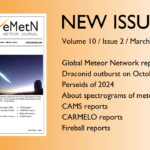Roberto Gorelli points our attention at a recently published meteor related paper.
Discovery of a Meteor of Interstellar Origin
This paper has been submitted for publication by Amir Siraj and Abraham Loeb.
Abstract: The first interstellar object, ‘Oumuamua, was discovered in the Solar System by Pan-STARRS in 2017, allowing for a calibration of the abundance of interstellar objects of its size ∼ 100 m. One would expect a much higher abundance of smaller interstellar objects, with some of them colliding with Earth frequently enough to be noticeable. Based on the CNEOS catalog of bolide events, we identify the ∼ 0.45m meteor detected at 2014-01-08 17:05:34 UTC as originating from an unbound hyperbolic orbit with 99.999% confidence. We infer that the meteor had an asymptotic speed of v∞ ∼ 42.1±5.5 km s^−1 outside of the solar system. Its origin is approximately towards R.A. 49.4±4.1° and declination 11.2 ± 1.8°, implying that its initial velocity vector was 58 ± 6 km s^−1 away from the velocity of the Local Standard of Rest (LSR). Its high LSR speed implies a possible origin from the deep interior of a planetary system or a star in the thick disk of the Milky Way galaxy. The local number density of its population is 10^6 AU^-3 or 9 × 10^21 pc^−3 (necessitating 0.2 – 20 Earth masses of material to be ejected per local star). This discovery enables a new method for studying the composition of interstellar objects, based on spectroscopy of their gaseous debris as they burn up in the Earth’s atmosphere.
You can download this paper for free: https://arxiv.org/pdf/1904.07224.pdf (5 pages).
Older meteor library news:
2019
- A Mathematical Model for Simulating Meteor Showers, by M. Cardinot and A. Namen. (4 June 2019).
- The 2019 Taurid resonant swarm: prospects for ground detection of small NEOs, by David Clark, Paul Wiegert and Peter G. Brown. (28 May 2019).
- Analysis of the June 2, 2016 bolide event over Arizona, by Csaba Palotai, Ramanakumar Sankar, Dwayne L. Free, J. Andreas Howell, Elena Botella and Daniel Batcheldor. (25 May 2019).
- Identifying Interstellar Objects Trapped in the Solar System through Their Orbital Parameters, by Amir Siraj and Abraham Loeb. (5 May 2019).
- Meteor Shower Modeling: Past and Future Draconid Outbursts, by A. Egal, P. Wiegert, P. G. Brown, D. E. Moser, M. Campbell-Brown, A. Moorhead, S. Ehlert and N. Moticska. (1 May 2019).
- Meteoroid structure and fragmentation, by M. D. Campbell-Brown. (24 March 2019).
- Solar cycle variation in radar meteor rates, by M. D. Campbell-Brown. (26 February 2019).
- A New Meteoroid Model, by Valeri V. Dikarev, Eberhard Grün, William J. Baggaley, David P. Galligan, Markus Landgraf, Rüdiger Jehn. (12 February 2019).
- Lunar impacts, by Costantino Sigismondi. (12 February 2019).
- Lunar impact flashes, by C. Avdellidou and J. Vaubaillon. (10 February 2019).
- The Geminid parent body: (3200) Phaethon, by Patrick A. Taylor, Edgard G. Rivera-Valentín, Lance A.M. Benner, Sean E. Marshall, Anne K. Virkki, Flaviane C.F. Venditti, Luisa F. Zambrano-Marin, Sriram S. Bhiravarasu, Betzaida Aponte-Hernandez, Carolina Rodriguez Sanchez-Vahamonde and Jon D. Giorgini. (10 February 2019).
- Sun approaching asteroids and meteor streams, by Quanzhi Ye and Mikael Granvik. (10 February 2019).
2018
- Waiting to make an impact: A probable excess of near-Earth asteroids in 2018 LA-like orbits, by C. de la Fuente Marcos and R. de la Fuente Marcos. (18 December 2018).
- What mechanisms dominate the activity of Geminid Parent (3200) Phaethon?, by LiangLiang Yu, Wing-Huen Ip and Tilman Spohn. (6 November 2018).
- The Draconid meteoroid stream 2018: prospects for satellite impact detection, by Auriane Egal, Paul Wiegert, Peter G. Brown, Danielle E. Moser, Althea V. Moorhead and William J. Cooke (21 September 2018).
- Modeling the measurement accuracy of pre-atmosphere velocities of meteoroids, by Denis Vida, Peter G. Brown and Margaret Campbell-Brown (15 July 2018).
2017
- The Mayas and Eta Aquariids in AD 250-909, by J.H. Kinsman and D.J. Asher (31 July 2017).


